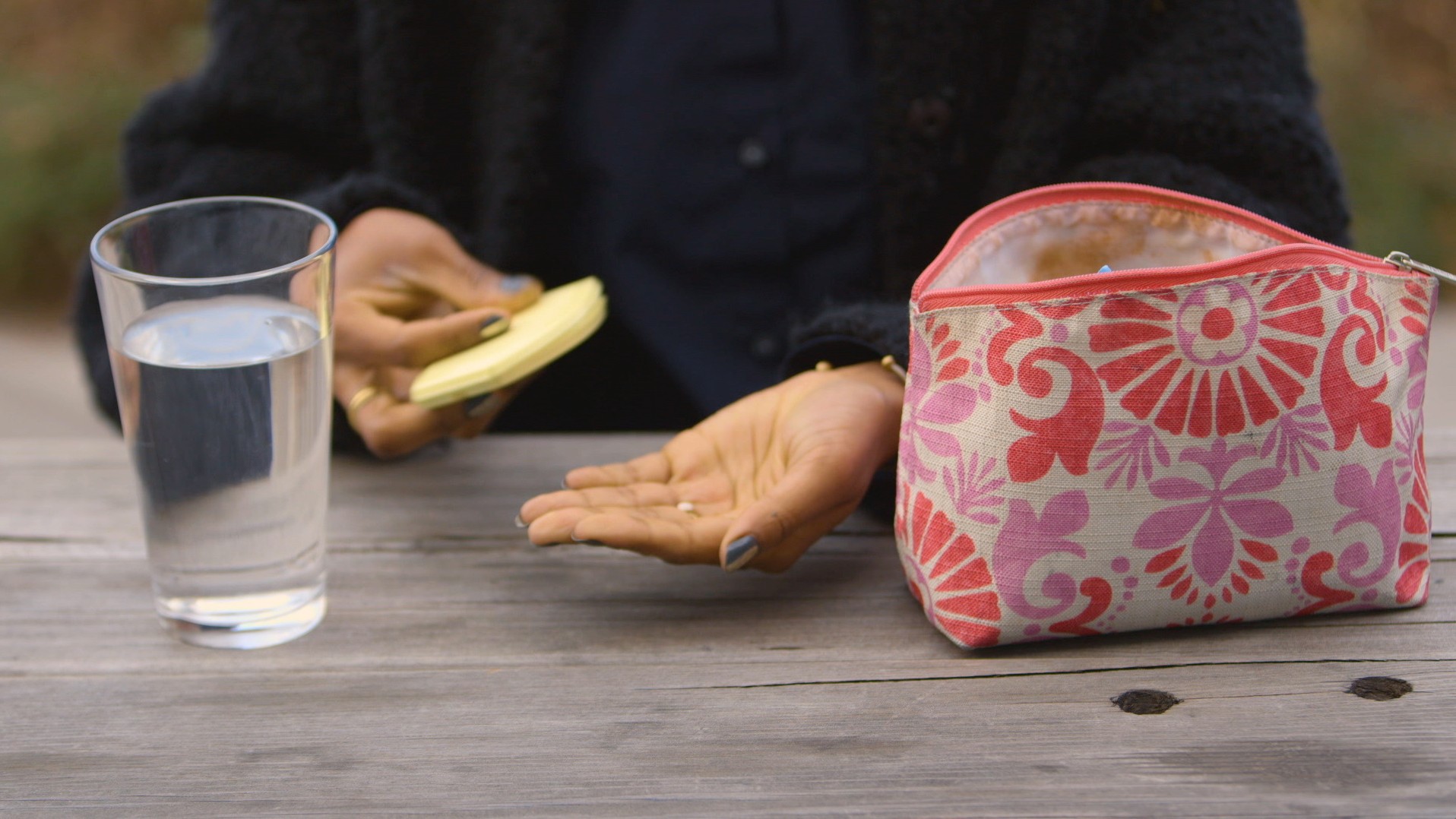In September 2016, JAMA Psychiatry published a Danish study that found a correlation between the use of hormonal birth control and being diagnosed with clinical depression. The study tracked hormonal birth control use and prescription of antidepressants over six years for over a million women. They found that women who were on hormonal birth control—be it the pill or a hormonal IUD or vaginal ring—were significantly more likely to be prescribed antidepressants.
Advertisement
Since the news broke, many women reported feeling vindicated that science is finally catching up to their lived experience. "I'd used the pill for ten years," says Holly Grigg-Spall, author of Sweetening the Pill. "One particular kind, Yasmin, had huge side effects —psychological effects, depression, anxiety, panic attacks. I didn't make the connection between what was going on with me and the pill for two years."The study found a particularly strong correlation between teenage birth control users and depression: there was an 80 percent increase risk for teens taking birth control to start taking antidepressants after going on the pill. This statistic is particularly troubling, especially as many teen girls are prescribed the pill before they're even sexually active—sometimes to treat acne or severe menstrual symptoms, and sometimes just as a general, preventative measure. "It was seen as an essential thing to do," says Grigg-Spall, "It was more of a rite of passage."
While it may be the first study of its kind to shed light on the relationship between hormonal birth control and depression, it's not the first to find a link between hormonal birth control and mood change. And it's only the latest in a long line of battles between women and their doctors over birth control.In the early part of the 20th century, contraception was illegal in most states, and 26 states banned single women from accessing contraception up until the 1960s. Women were often at the mercy of their uterus, enduring unplanned pregnancy after unplanned pregnancy. One common solution was hysterectomies. "We did them early after delivery. Six weeks, seven weeks postpartum," said Dr. Richard Hauskenecht in the PBS documentary, American Experience: The Pill. "Doing a vaginal hysterectomy on somebody who's had three or four kids, six weeks postpartum, you got two choices: You either got to be faster than hell, or you'd better get the blood bank cranked up because the blood loss will be astonishing. It was prehistoric, absolutely prehistoric."Read more: How Messing with Your Birth Control Affects Your Body
Advertisement

Hormonal birth control was pioneered by four people: Activist and sex educator Margaret Sanger, who appealed to the eugenics movement to advocate for birth control, biologist Gregory Pincus, suffragist and millionaire heiress Katherine McCormick, and Catholic physician and gynecologist John Rock. Pincus discovered that animals injected with progestin did not ovulate. But frequent injections weren't seen as a viable solution, so the push went towards developing an oral contraceptive. McCormick funded the development of the pill out of her own pocket. By the 1950s, Rock provided test subjects by giving the pill to his patients in Massachusetts under the guise of a fertility study. He did not inform his patients that the pill was designed to prevent them from getting pregnant. Many women dropped out of the initial Massachusetts study because they couldn't tolerate the side effects: bloating, potentially fatal blood clots, and mood changes. The team began to have difficulty getting clinical trials off the ground in America, partially because contraception was still illegal in most states and partially because of the high drop out rate from their smaller studies. So Pincus and Rock looked to Puerto Rico, where concerns about overpopulation fueled in part by the eugenics movement meant there were no birth control restrictions and abortion was legal on the island. In fact, many Puerto Rican women were sterilized without their consent or knowledge in a procedure that was colloquially known as "La Operacion" in the 1950s and 60s. Pincus and Rock assumed that they would find a large, compliant population of test subjects. They believed that if poor, uneducated Puerto Rican women could use the pill, anyone could.
The team began to have difficulty getting clinical trials off the ground in America, partially because contraception was still illegal in most states and partially because of the high drop out rate from their smaller studies. So Pincus and Rock looked to Puerto Rico, where concerns about overpopulation fueled in part by the eugenics movement meant there were no birth control restrictions and abortion was legal on the island. In fact, many Puerto Rican women were sterilized without their consent or knowledge in a procedure that was colloquially known as "La Operacion" in the 1950s and 60s. Pincus and Rock assumed that they would find a large, compliant population of test subjects. They believed that if poor, uneducated Puerto Rican women could use the pill, anyone could.

Advertisement
At first, Rock and Pincus again had trouble finding women who would tolerate the pill's side effects. "Women in Puerto Rico dropped out of the study, too, and so they started looking for women they could force to participate, both at home and in Puerto Rico'" writes Ann Friedman in The New Republic. "Women locked up at a Massachusetts mental asylum were signed up. Women enrolled in medical school in San Juan were told they had to take part in the medical test or face expulsion." Again, these women weren't told what the pill was for; instead, they were supposed to shut up, take their medicine, and submit to frequent, invasive medical exams.
Eventually Dr. Edris Rice-Wray, medical director of the Puerto Rico Family Planning Association, came up with a new strategy: Tell women what the pill is supposed to do. Social workers began going door to door in San Juan housing projects, explaining that a pill could be taken daily to prevent pregnancy. Once women were told what the pill did, they signed up by the hundreds. However, these women were not informed that they were part of a clinical trial or that the treatment was experimental.After the study was concluded, Dr. Rice-Wray told Rock and Pincus that the pill was 100 percent effective in preventing pregnancy. However, 17 percent of participants suffered from side effects such as "nausea, dizziness, headaches, stomach pain and vomiting."Read more: The Controversial Birth Control That Destroys Your Body
Advertisement
Three women died during the study and were never autopsied to see if their participation led to their deaths. Dr. Rice-Wray concluded that the pill, at least in the form and dosage it was given to Puerto Rican women, had "too many side reactions to be generally acceptable."This did not stop G.D. Searle & Co. from releasing the first version of the pill, Enovid, in the same formulation that caused illness in almost a fifth of the participants in the clinical trial. Enovid contained 10 times the amount of hormones needed to prevent pregnancy.

Incidentally, Pincus et al. had originally looked at hormonal birth control for men. "It was rejected for men due to the number of side effects," says Grigg-Spall, "including testicle shrinking." It was believed women would tolerate side effects better than men, who demanded a better quality of life.In 1970, journalist Barbara Seaman wrote The Doctors' Case Against the Pill. The book detailed the many side effects of Enovid—anecdotal data doctors knew but withheld from their patients. The book was brought to the attention of Wisconsin senator Gaylord Nelson."Senator Nelson wanted a patient's right-to-know bill," says National Women's Health Network executive director Cindy Pearson. The pill was his entry point for making the medical industry more transparent to consumers. Nelson convened Senate hearings in January 1970 to investigate the link between pill usage and decrease in libido, depression, and blood clots. No women were asked to speak at the hearings. Members of the D.C. Women's Liberation collective, led by Alice Wolfson, protested the lack of female participation in the hearings. "It must be admitted that women make superb guinea pigs," said Wolfson at the hearings. "They don't cost anything, they feed themselves, they clean their own cages, pay for their own pills, and remunerate the clinical observer. We will no longer tolerate intimidation by white-coated gods antiseptically directing our lives."
Advertisement
The Nelson Pill Hearings led to the amount of hormones being greatly decreased in oral contraceptives, as well as a 100-word insert on the potential side effects added to every package of the pill.While it's easy to laugh now at the long list of potential side effects listed at the end of every pharmaceutical commercial, it was those who fought for transparency over the birth control pill that gave the people the right to know the risks with each drug we put in our bodies. Additionally, the ethically reprehensible and deeply racist Puerto Rican clinical trials led directly to the informed consent procedures that all medical studies must adhere to today.Barbara Seaman and Alice Wolfson, the women who met at the Nelson Pill Hearings, went on to co-found the National Women's Health Network.Today, Pearson reflects on the way hormonal birth control shaped her organization and its mission. "Contraception is just one example of where we feel women should know as much as they want to know," Pearson says. The new Danish study hasn't changed her opinion of hormonal birth control."The risk of depression has been recognized since women were able to get their hands on oral contraceptives," she says. What's changed is now there's data to back up the experience of many women. "It makes sense biologically," she says, "and it's been reported by women for 50 years."
Trust women to make good decisions when they have good information.
Advertisement
But if women have been reporting depression as a side effect of hormonal birth control for 50 years, why are we only now getting solid data? "A big part of it is lack of interest in women's health issues as a whole," says Grigg-Spall, who adds that studying mood is complicated, "because obviously there are so many other factors."Much of the criticism of the Danish study points to the excess of other variables in the onset of depression. Some point to the idea that the spikes in teen depression are about lovesickness, not a change in hormonal balance brought on by birth control. Others indicate that some media outlets have misinterpreted the correlations reported to be greater than they are. Grigg-Spall praised the data gathered by the Danish scientists, especially because prescription of antidepressants was the measure of depression, she says. "It looked at the data; it didn't ask them to self-rate."
Pearson was also very enthused by the Danish data. "God bless the Scandinavians for having universal health care and keeping really good statistics!" she says. "It provides really good leads that can be further investigated." One such lead that needs further investigation: why comparatively low-hormone birth control like IUD's and vaginal rings correlated with more depression than higher-hormoned pill takers.According to Pearson, the whole point of studies like this is to give women the information they need to make their own choices about their bodies and their health. "This information shouldn't be hidden from women for the fear that they will make a wrong decision down the line," she says. "Trust women to make good decisions when they have good information."
